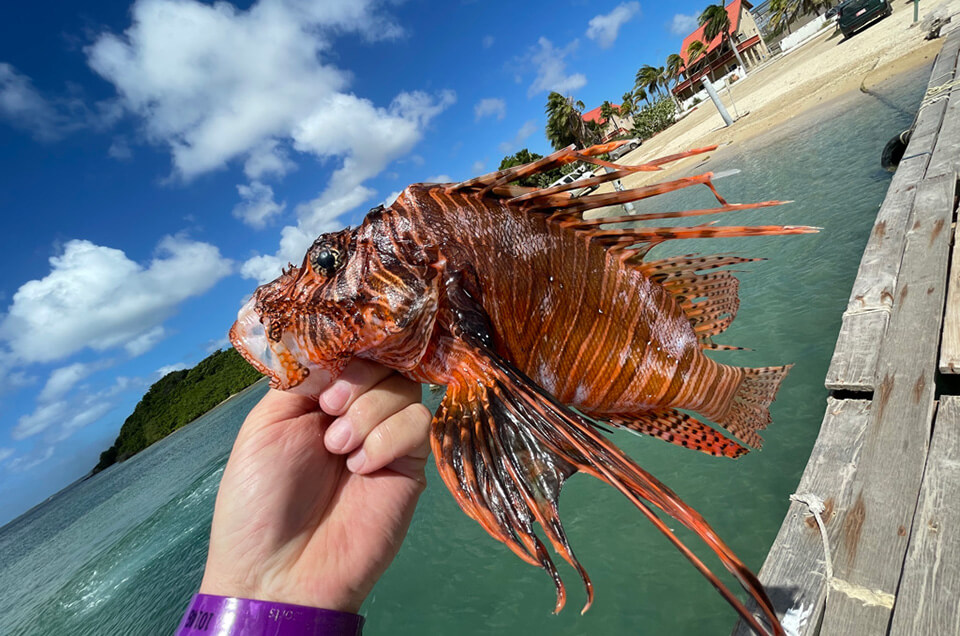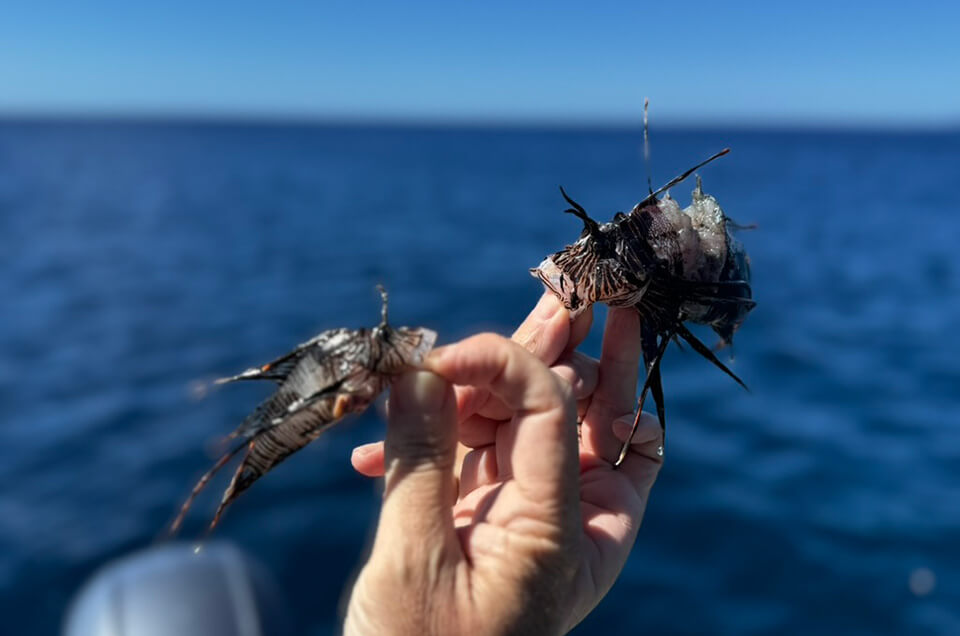Lionfish Habitat: Where Do Lionfish Live?

Certain species can spread outside their natural habitats and invade other areas, causing harm to the environment. These are known as invasive species. One of the flourishing invasive species is the lionfish, a carnivorous fish that originated in the Indo-Pacific area and has invaded the Atlantic Ocean, impacting its ecosystems.
Founded by International Lionfish Hunter and Professional Scuba Instructor, Roger J. Muller, Jr. of Muller Insurance, Lionfisherdivers.com is dedicated to educating people on the negative effects of lionfish, as well as removing lionfish from the ocean through lionfish hunting. Learn more about this invasive species, the natural lionfish habitat, and where they currently live.
What Are Lionfish?
Lionfish are a type of predatory marine fish with brown or white stripes on their bodies and fan-like fins that distinguish them from other fish. They also feature venomous spines used to fend off predators and capture their prey. There are several different subtypes of lionfish, including:
- African lionfish (Pterois mombasae)
- Clearfin lionfish (Pterois radiata)
- Common lionfish (Pterois miles)
- Luna lionfish (Pterois lunulata)
- Red lionfish (Pterois volitans)
- Spotfin lionfish (Pterois antennata)
Lionfish are bothersome to humans, having venomous stings that cause painful punctures, blisters, and other distressing symptoms. However, they do not purposely attack humans, rather stinging out of a defensive mechanism. Lionfish are also edible (and tasty) for humans after they have been properly cleaned, had their venomous spines removed, and filleted.
Why Are Lionfish Considered Invasive?
Lionfish are an invasive species, which means they have spread outside of their natural habitat and have the potential to negatively affect the environment and ecosystem of the invaded area. Since lionfish aren’t native to these invaded areas in the Caribbean there are not many known predators there. This allows them to be at the top of the food chain and helps their population keep growing, along with their rapid reproduction rates. Female lionfish can release around 15,000 fertilized eggs at a time and as many as 2,000,000 eggs per year.
Lionfish traditionally ate crabs, shrimp, and other fish in their natural habitat, but now consume more than 50 species of fish, including some crucial species to the environment and ecosystem. A lionfish will eat about 60,000 reef fish by the time it turns two, on average. This means that lionfish can out-compete with the other species and further affect the food chain. For these reasons, lionfish are considered harmful to non-native waters, and people are beginning to participate in lionfish hunting to remove them.
To learn more about lionfish and their effect on non-native ecosystems, check out this YouTube video from Lionfishdivers.com, translated into English and Spanish. You can also read the Lionfish Educational Flip Books Vol. 1 and Vol. 2 for further insight.
Where Are Lionfish Native To?
The natural habitat of lionfish is in the waters of the Indo-Pacific region, which consists of the South Pacific and Indian Oceans. This region spans a large area from Japan to western Australia, Indonesia, and more surrounding areas. Lionfish traditionally prefer tropical, warm seas with places to retreat like seagrass, coral reefs, and rocky crevices.
Where Are Lionfish Currently Found?
As mentioned above, lionfish are an invasive species, spreading to non-native locations and affecting their ecosystems. The first lionfish was identified in South Florida waters in 1985 and they have continued to increase in numbers ever since, now invading many areas of the Atlantic Ocean. Lionfish have been found in the:
- Eastern seaboard of the United States
- Gulf of Mexico
- Caribbean Sea
- Southeast coastal waters in Florida and North Carolina
- Northeast coastal waters of Long Island, New York
Since lionfish aren’t native to these areas in the Atlantic Ocean, the predators that live in their natural habitat like eels, frogfish, and scorpion fish aren’t there. This lets the lionfish make their way to the top of the food chain, allowing them to reproduce and thrive in the Atlantic Ocean. However, this isn’t good for the rest of the ecosystem and causes damage to the underwater environment.
Lionfish in Florida
The very first lionfish discovered in the Atlantic Ocean was in Florida, and they have continued to increase their population there ever since. Because lionfish are invasive and can damage the existing natural ecosystem, the Florida Fish and Wildlife Conservation Commission (FWC) encourages divers, anglers, and commercial harvesters to remove lionfish they spot in Florida waters. They also help to spread information and resources about lionfish, hunting them, and eating them.
Lionfish in the Caribbean
Over the last 10 years, two main species of lionfish (Pterois volitans and P. miles) have invaded the Atlantic and Caribbean reefs. These fish threaten the ecosystem and fish populations across the region, hurting the people who depend on them. Research has shown that just one lionfish living on a coral reef can reduce the presence of native reef fish by nearly 80 percent. This causes further harm to the reefs that are already damaged by climate change, overfishing, and other factors.
Some Caribbean governments are developing lionfish management plans to help control the level of lionfish. For example, there are many policy amendments that support the control efforts for lionfish. Caribbean governments have also popularized the selling and consumtion of lionfish meat, creating markets that allow individuals to sell it. In turn, that can encourage lionfish hunting and bring awareness to the cause.
How Did Lionfish Spread?
You’re probably wondering how lionfish have managed to spread and invade waters so far away from their natural habitats. Although researchers aren’t sure of the exact cause, it is believed that humans have helped it along. Lionfish are commonly kept in home aquariums in the U.S. because of their striking appearance of bold, zebralike stripes.
However, as they grow and become larger, people have resorted to releasing their lionfish into the Atlantic Ocean, not realizing the hazardous effects it could have. Lionfish reproduce rapidly and don’t have known predators in the Atlantic, so they have experienced uncontrollable growth there. Unfortunately, once an invasive species has infiltrated an area and established a population, it will continue to grow and can be difficult or impossible to eliminate using conventional methods.
Ways to Help Combat the Lionfish Invasion
The lionfish invasion of the Atlantic and Caribbean waters has caused damage to the ecosystems there and will continue to do so as they keep growing their population. Lionfishdivers.com was created to spread awareness of lionfish and lionfish hunting in the Atlantic Ocean, from New Jersey down to Florida. Led by Roger J. Muller, Jr., an international lionfish hunter and insurance agent, Lionfishdivers.com offers information and videos to spread the word about lionfish. Topics include ways to help combat the lionfish invasion, including:
Lionfish Hunting
One of the ways that humans have started to counteract the lionfish invasion is through lionfish hunting, or the sport of killing the species. Lionfish can be difficult but exciting to catch since they’re rarely caught using a traditional hook-and-line, but rather with methods like spearing and hand-held netting. To hunt lionfish, you’ll need the proper hunting equipment to stay safe from the venomous spines, including a spear, spear tips, a containment device, and puncture-resistant gloves. There are even lionfish hunting tournaments and competitions that people can participate in to find and catch the largest lionfish, as well as sponsors by Emerald Cost, Lionfishdivers.com, and Muller Insurance.
Eating Lionfish
Another way humans can help fight the lionfish invasion is by eating them, although this requires them to be hunted first. More and more restaurants and vendors are starting to sell lionfish, as it’s quite tasty when cleaned and cooked correctly.
The process involves carefully removing the venomous spines, using safe handling tips, filleting it like any other fish, and cooking it. Lionfish has a taste like snapper or grouper and can be prepared in several ways, including baked, fried, broiled, grilled, blackened, and more. For inspiration on serving lionfish, check out these lionfish cooking videos.
Some other ways to help with the lionfish invasion include reporting any lionfish sightings to the local authorities, sharing information on lionfish, and donating to lionfish containment and tracking efforts. People have even started making and selling lionfish jewelry, which uses the uniquely patterned fins from lionfish remains to create wearable art. Sara Newton is one example of this, starting her own shop called Lionfish Predators. Here, Newton creates beautiful accessories and décor items made from lionfish fins.
Lionfish Predators is not the only business with a dedication to lionfish eradication through jewelry. The following shops and individuals have that same passion:
- Lionfish Huntress, Christine Raininger: Instagram and Etsy
- Lionfish Caribbean, Lisette Keus
- Lionfintastic, Susan Heiter: Facebook and Etsy
Frequently Asked Questions about Lionfish
Are lionfish poisonous?
Lionfish are not poisonous, they are venomous. The difference between the two comes down to how it is given to the subject. With venom, it must be injected into the body, either through bites, spines, fangs, or stingers. Poison must be inhaled or ingested for the toxin to work, which isn’t the case for venom.
Can you catch lionfish in a trap?
Lionfish are best caught using a spear, but they can also be caught in hand-held nets or occasionally in commercial lobster and crab traps. However, research has shown that lionfish are not getting stuck in traps but can get in and out freely. This means they’re only caught when they’re inside the traps as they’re pulled up.
Dr. Stephen Gittings is a National Oceanic and Atmospheric Administration (NOAA) scientist, acting as a science coordinator for the National Marine Sanctuary Program. Dr. Gittings conducts research in 12 marine sanctuaries, looking for ways in which predators and other factors can affect the ocean’s ecosystem. This research has allowed Dr. Gittings to develop a new type of lionfish trap, which is designed to catch lionfish that swim below the scuba diving depth.
How long do lionfish live?
On average, lionfish live for 10 to 15 years in the wild but can live even longer in captivity. They can also grow to be up to 15 inches long on average, with some growing larger at 18 inches. The long lifespan and growth of lionfish are believed to have contributed to the illegal dumping of lionfish in the Atlantic Ocean after people’s lionfish pets outgrow or outlive their captive habitat.
What are the effects of a lionfish sting?
After getting a lionfish sting, a person will experience intense pain at the puncture wound, usually followed by swelling, redness, and bruising. Some people also experience shortness of breath, dizziness, nausea, sweating, fainting, and even temporary paralysis.
The effects of a lionfish sting may take several days to completely subside. How long the symptoms last depends on how deeply the spines punctured the body, how much venom was delivered, and the person’s health condition. For a firsthand account of how it feels to be stung by a lionfish, see Roger J. Muller’s video about being stung by a lionfish during a great dive in Dominica.
What should you do if you get stung by a lionfish?
If you know you’ve been stung by a lionfish, the first step is to remove the spines from the wound. It’s important that the person removing them wears puncture-resistant gloves or tweezers and tries to avoid squeezing the venom glands, which are located within the spine. There are also treatments that work to alleviate the pain and stinging associated with a lionfish sting, such as Stingmaster sting cream and other lionfish products.
The wound should then be washed with soap and water and soaked in hot water to reduce the pain. Over-the-counter medications can also be used. It’s best to contact your doctor after to ensure you have your tetanus immunization and to ask about any further care recommendations. People with severe symptoms after a lionfish sting should visit an urgent care center or emergency room.
Request More Information about Lionfish Today
Whether you’ve just learned about lionfish or known of their invasion for a while, it’s time to get involved in the efforts. You can educate others about lionfish, prepare a lionfish recipe, buy a cool pair of lionfish earrings, or even explore lionfish hunting. To learn more about lionfish and how you can help prevent further environmental damage, contact Roger J. Muller, Jr., at Lionfishdivers.com today.





